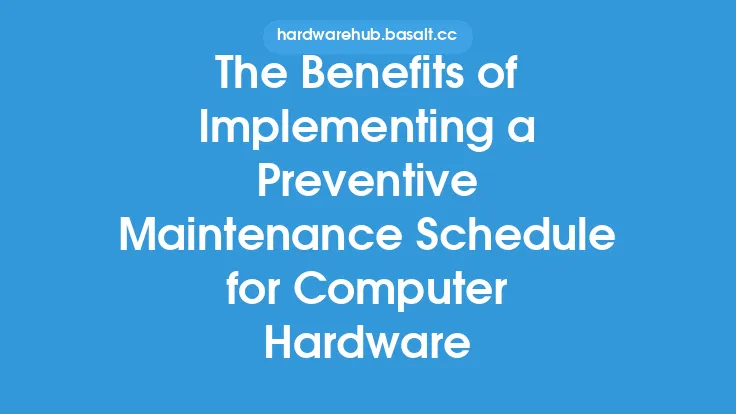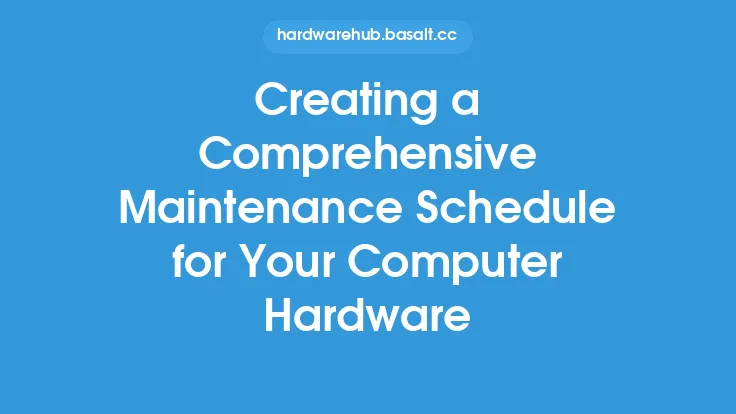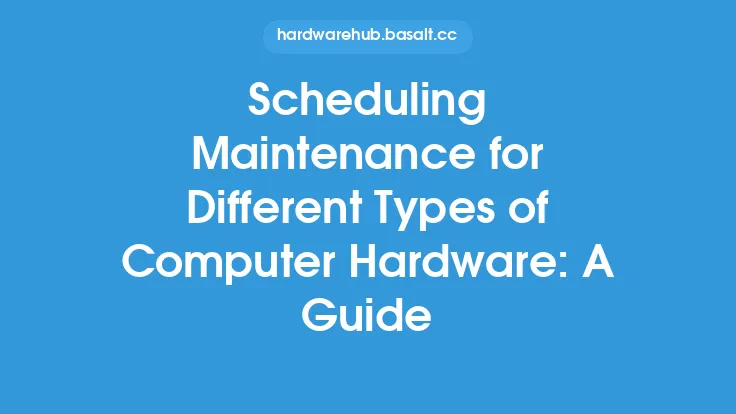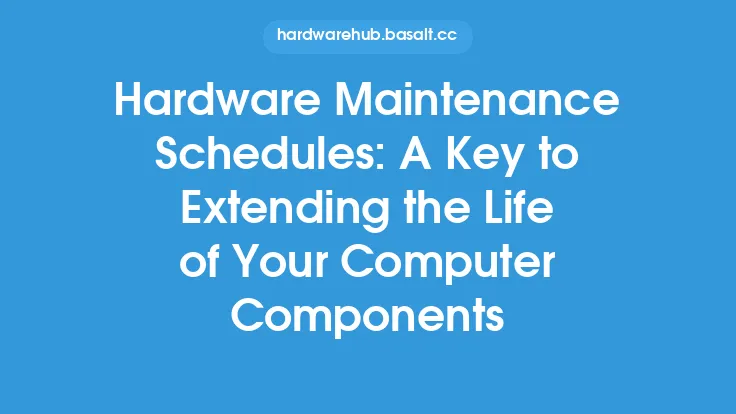When it comes to newly purchased computer hardware, developing a maintenance schedule is crucial to ensure optimal performance, prevent downtime, and extend the lifespan of the components. A well-planned maintenance schedule helps to identify potential issues before they become major problems, reducing the risk of data loss, system crashes, and hardware failures. In this article, we will delve into the importance of creating a maintenance schedule for newly purchased computer hardware and provide a comprehensive guide on how to develop an effective plan.
Understanding Computer Hardware Components
To develop a maintenance schedule, it's essential to understand the different components that make up a computer system. These include the central processing unit (CPU), motherboard, memory (RAM), storage devices (hard drives or solid-state drives), power supply, graphics card, and peripherals such as keyboards, mice, and monitors. Each component has its unique characteristics, requirements, and maintenance needs. For instance, storage devices require regular backups and disk cleanups, while graphics cards need driver updates and cooling system checks.
Identifying Maintenance Requirements
To create a maintenance schedule, you need to identify the specific maintenance requirements for each hardware component. This includes tasks such as:
- Cleaning dust from fans, heat sinks, and vents to prevent overheating
- Updating drivers and firmware to ensure compatibility and security
- Running disk cleanups and disk defragmentation to optimize storage performance
- Checking for loose connections and cables to prevent damage and data loss
- Monitoring system logs and event viewers to detect potential issues
- Performing backups and data transfers to prevent data loss
- Checking for BIOS updates and flashing the BIOS when necessary
Creating a Maintenance Schedule
Once you have identified the maintenance requirements for each component, you can create a schedule that outlines the tasks to be performed, the frequency of each task, and the responsible person or team. A maintenance schedule can be divided into daily, weekly, monthly, quarterly, and annual tasks. For example:
- Daily tasks may include monitoring system logs, checking for updates, and performing quick cleanups
- Weekly tasks may include running disk cleanups, checking for malware, and performing backups
- Monthly tasks may include updating drivers, checking for BIOS updates, and performing thorough cleanups
- Quarterly tasks may include checking for loose connections, inspecting cables, and performing system diagnostics
- Annual tasks may include performing a thorough system overhaul, replacing worn-out components, and upgrading hardware
Tools and Software for Maintenance Scheduling
There are various tools and software available to help you create and manage a maintenance schedule. These include:
- Calendar applications such as Google Calendar or Microsoft Outlook to schedule tasks and set reminders
- Maintenance management software such as Nagios or SolarWinds to monitor system performance and detect potential issues
- Disk cleanup and defragmentation tools such as Disk Cleanup or Defraggler to optimize storage performance
- Driver update software such as Driver Booster or Driver Talent to ensure driver compatibility and security
- Backup software such as Acronis or Macrium to perform backups and data transfers
Best Practices for Maintenance Scheduling
To ensure the effectiveness of your maintenance schedule, follow these best practices:
- Prioritize tasks based on importance and urgency
- Set realistic deadlines and allocate sufficient time for each task
- Assign tasks to responsible personnel or teams
- Monitor and review the schedule regularly to ensure compliance and effectiveness
- Document all maintenance activities, including tasks performed, results, and recommendations
- Continuously update and refine the schedule as new hardware components are added or removed
Common Mistakes to Avoid
When developing a maintenance schedule, avoid the following common mistakes:
- Neglecting to perform regular backups and data transfers
- Failing to update drivers and firmware regularly
- Ignoring system logs and event viewers
- Not checking for loose connections and cables
- Not performing thorough cleanups and inspections
- Not documenting maintenance activities and results
Conclusion
Developing a maintenance schedule for newly purchased computer hardware is essential to ensure optimal performance, prevent downtime, and extend the lifespan of the components. By understanding the different hardware components, identifying maintenance requirements, creating a schedule, and using the right tools and software, you can develop an effective maintenance plan. Remember to follow best practices, avoid common mistakes, and continuously update and refine the schedule to ensure the longevity and performance of your computer hardware.





